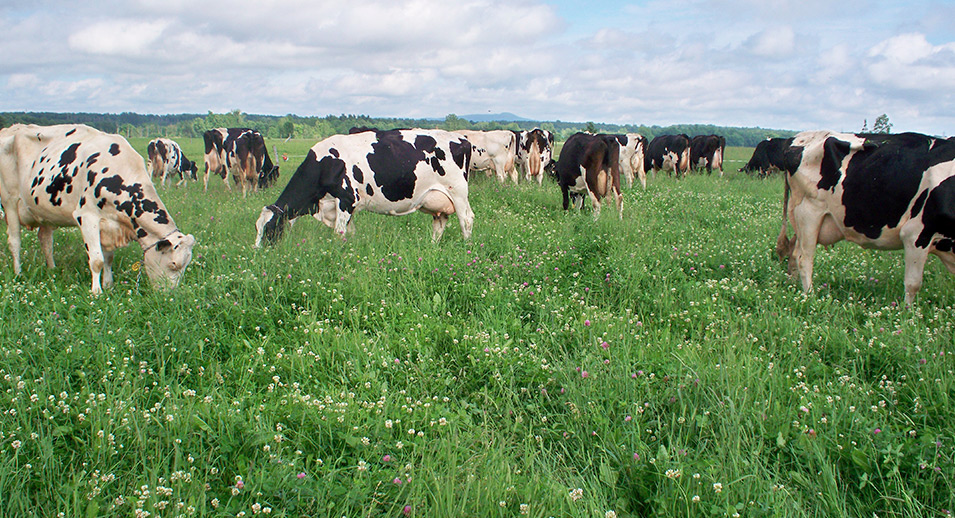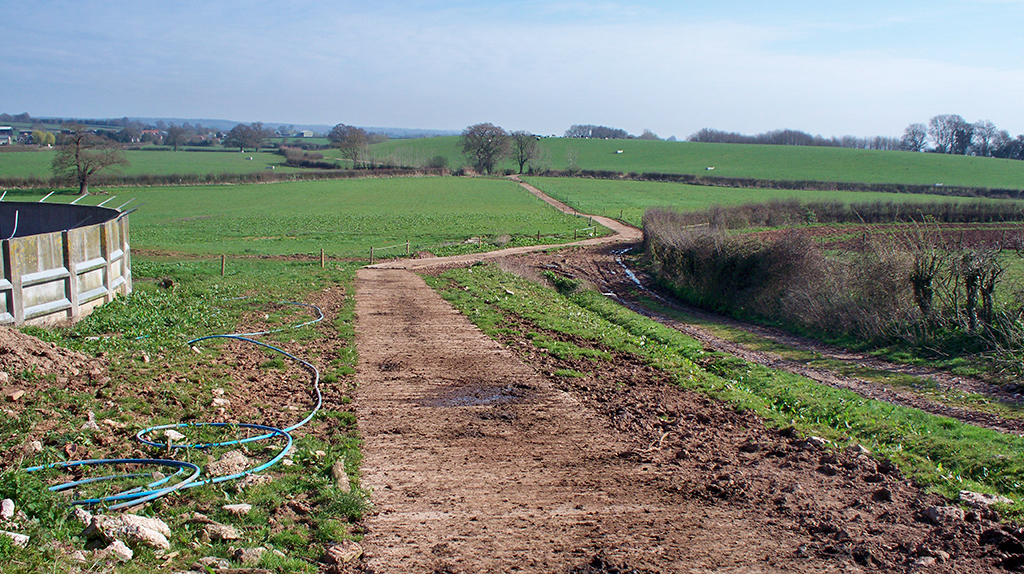Dairy cows on pasture: myths versus facts
- July 7, 2020
- Le Producteur de Lait Québécois Magazine
Apart from organic herds, there aren’t many cows on pasture on Canadian farms. Yet, it’s common practice in other parts of the world. Why not here?

Could it be due to negative perceptions dating from pasture use in times gone by? Are these perceptions still valid when it comes to current practices? To separate fact from fiction, let’s look at research findings and the practices of producers in Quebec.
Myth
Fact
In most areas of Quebec, the grazing season can easily last 4 to 6 months a year, and even longer in some parts of the country. Under intensive management, pasture areas are subdivided into a number of small paddocks that are grazed in sequence. This allows sufficient time for regrowth between successive grazings and ensures a supply of high-quality herbage that meets the requirements of lactating cows, regardless of their production level.
For a good balance between quantity and quality, lactating cows are offered forage that is 20-25 cm (8-10 in.) tall in each paddock. At this height, a mixture of grasses and legumes contains an average of 20 per cent crude protein and 1.5 Mcal /kg net energy lactation. In terms of energy, that’s almost the equivalent of silage corn, but with a lot more protein!
Myth
Fact
Moving animals out to pasture is often assumed to be a time-consuming task that increases the workload. But it all depends on the setup. In an intensive grazing system, with an access road and well-established parcels of pasture, the time factor is minimal since the cows quickly adapt to the routine of the pasture season.
Another aspect often overlooked is the time saved in the barn and the fields, since cows on pasture effectively feed themselves, harvest their own forage and spread the manure all on their own. The greater the proportion of grazed forage, the more time saved. Quebec farmers who have transitioned to pasture-based systems have all noted a decrease in the number of hours they spend in the barn and on a tractor in the summer.
Myth
“My land is worth too much to use it for pasture.”
Fact
On farms that are already growing forage crops, implementing a grazing system means converting grassland to pasture. Under intensive management, improved pastures (regular seeding every 5 years or so) produce yields comparable to those of mechanically-harvested pastures. Hence the area devoted to forage crops need not change.
Moreover, management-intensive grazing allows cows to feed on young, nutrient-rich grass 4 to 6 times per season, in a same pasture parcel. Rotational grazing provides higher yields than continuous grazing and helps prevents rejection. It’s hard to get such consistent forage quality from one mechanical harvest to the next.
Because pastures are harvested and fertilized by the cows, production costs for grazed forage are about half those of mechanically-harvested forages, which cost an average of $235/t1. This substantial difference is attributable to decreased expenses for the purchase of certain inputs and, most importantly, to savings related to the cost of harvesting equipment (purchase, maintenance, operation, etc.).
With production costs this low and high yields under intensive management, pastures are the champions of forage production, as much for quality as cost!
Myth
“It’s often too hot outside for the cows in summer. They’re a lot more comfortable in the barn, and they don’t want to go outside anyway!”
Fact
There are a number of ways to avoid heat stress in pasture-based systems. The simplest is to put the cows out at night, right after the last milking, so they can graze and get some exercise without being subjected to the heat of the day. They can return to the barn early in the morning to take advantage of the shade and ventilation inside. It’s the best of both worlds! For producers who graze their herds in the daytime as well, the cows can either be put out on pasture in the morning only, or spend the whole day outside if they can be provided with shade (e.g. with windbreaks).
In studies² where cows already accustomed to grazing were given a choice, the animals spent an average of 62 per cent of their time on pasture and the rest in the barn. This shows that cows prefer grazing, even when they have access to silage and concentrates inside. Overall, it seems that cows are more attracted to the comfort, forage and environment that pastures provide.
Myth
Fact
Based on the herds of hundreds or even thousands of cows on pasture in Europe and New Zealand, respectively, herd size is not a limiting factor. In Quebec, for example, there are herds of a few hundred cows on pasture. To be successful, however, the grazing setup needs to be adjusted to the size of the herd, as is the case in the barn.
One of the most important elements is the access road to the pasture, which needs to be reinforced to support increased traffic. Access roads must be well drained and stable at all times. Depending on the soil type, this may simply mean shaping drainage slopes, adding sand or, in more challenging cases, installing a geotextile covered in gravel and finished with a finer layer to avoid hoof injuries. For larger herds, higher traffic sections of the road can even be covered in concrete to prevent them from becoming muddy trenches.

Cows are known to be social animals and creatures of habit, and these behaviours actually make it easier to turn large herds out on pasture. The experience of large-herd owners is clear in this respect. Cows quickly learn that the effort of moving from paddock to paddock will be rewarded with an abundance of fresh grass. The same applies to the return trip to the barn, where the cows know that concentrates will be available, for example. Once these conditions are in place, handling a herd – large or small – becomes a walk in the park!
Myth
Fact
Based on a recent literature review, it is actually total or partial confinement systems rather than grazing that are associated with an increased incidence of health problems such as lameness due to infectious (e.g., digital dermatitis) and non-infectious (e.g., sole ulcers) causes, clinical mastitis, high SCC, metritis or endometritis. Mortality rates were also found to be lower in herds on pasture. On the other hand, the risk of internal parasites is higher in grazing cows.
Studies focused on reproduction tend to indicate a general improvement in fertility for herds on pasture, but further research would be needed to draw conclusions.
Myth
Fact
Research² shows that the milk yields of cows fed only grazed forages are comparable to those of cows confined to the barn year round, for a same quantity of concentrates. The results are the same when total confinement systems are compared to partial confinement systems (half-days on pasture), the latter being the most common practice in Quebec.
Another interesting finding is that milk produced by grazing cows contains up to twice as much CLA (conjugated linoleic acid), one of the fats considered to be beneficial to human health.
Myth
Fact
Electric fencing has become more sophisticated over the years. Electric fence controllers, or energizers, compensate for voltage drops and are connected to a remote control unit that can detect power outages or cut power at any point in the fencing network by simply touching the wire.
For permanent fencing, aluminum wire, which is lighter and a better conductor, can be used with steel or fibreglass posts, which are easier to install and to maintain and last longer than wooden posts. For temporary fencing used to subdivide pastures into strips, gear reels, portable posts and light wiring work very well.


Myth
Fact
Countries like Ireland and New Zealand have clearly shown that robotic milkers can be used within a total grazing system. By installing the robot in the right place in the barn and providing up to three grazing paddocks per day, cows can be trained to visit the milker almost as often as in a total confinement system. A number of organic milk producers in Quebec have been successful in combining both robotic milking and grazing.
Based on the latest research and the hands-on experience of producers both here and elsewhere, it is clear that some of the negative perceptions regarding grazing are related more to myth than to reality. For both technical and economic reasons, grazing systems should be given greater scope on our dairy farms.
As concerns about animal welfare increase among consumers and producers, pasture-based systems may help address some of these issues. We often hear about the wish to see cows in the fields in the summertime. This means that in addition to the advantages for the farm itself, grazing also serves to enhance the overall image of dairy farming in Quebec and in other Canadian provinces. And finally, pastures deliver benefits for the environment and biodiversity as well!
1 Average production cost for hay and haylage, Agritel, 2016-2018.
² A literature review of 196 scientific articles: A comparison of confinement and grazing systems for dairy cows: What does the science say? Gareth Arnott, Conrad Ferris, Niamh O’Connell, March 2015










